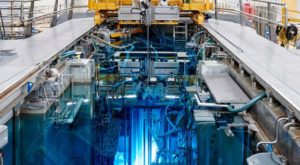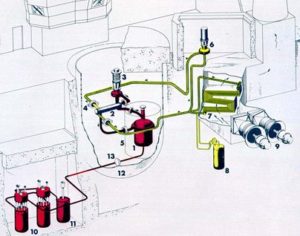A Long-needed Paradigm Shift in Nuclear Fuel Usage:
Molten Salt Reactor
Introduction:
Nuclear technology is broadly used by many developing and industrial countries as a huge source of electric energy. Over the last 50 years, nuclear technology has developed greatly and has accumulated hundreds of years of experience on various types of reactors. Nuclear fuels are the source of all of all nuclear energy and are collected from the finite resources available on earth. Different types of fuels are used for in various reactors such as MOX fuel, UOX fuel, metal fuel, liquid fuels etc. One of the most attractive liquid fuel is Molten Salt- a salt of metallic fluorides heated above its melting point- used in a molten salt reactor which is apparently the safest, most sustainable and cost-efficient nuclear reactor so far.
Background:
MSR started its journey as an experiment to attain a higher energy density. The research started as a high-temperature molten salt experiment at Oak Ridge National Laboratory (ORNL) in the 1960s. The Molten Salt Reactor Experiment (MSRE) under ORNL operated from 1965 to 1969 to test different MSR related theories/materials as well as operational characteristics. Unfortunately, despite all these researches having been proved effective, US has not taken any significant initiative in employing MSR on a large scale which indeed is a long-term need of both human and the environment.
Figure: Molten-Salt Reactor Experiment. (2018, June 17). Retrieved from https://en.wikipedia.org/wiki/Molten-Salt_Reactor_Experiment
Process:
Nuclear power plants generate electricity through a fissile chain reaction. Fissionable Isotopes such as Uranium-235, 233 or Plutonium-239 absorb a neutron and split apart. That neutron then hits another atom and splits it apart exerting more heat. This chain reaction called fission keeps going on. The fuel contains fissionable isotopes. The moderator slows down the neutrons which slows down the whole process and the coolant carries the exerted heat from fission away from the reactor to heat exchanger and thus cools down the reactor while supplying heat energy to the turbine.

Figure: Part 8–The Molten Salt Reactor concept. (2012, June 01).
Retrieved from https://daryanenergyblog.wordpress.com/ca/part-8-msr-lftr/
In a Molten Salt Reactor (MSR,) the core operates differently than various other power plant reactors. The primary coolant and fuel source in a molten salt reactor is a salt that is heated above its melting point so it’s in a liquid phase. In MSR, graphite rods work as a moderator. Through the chemical processing plant, adjustment can be made to the fuel composition. The freeze plug and overflow tanks provide safety from expansion and explosion by providing space and cooling to the fuel.
Advantages:
Molten salt reactors are more efficient than the other types of reactors in all aspects. It is a thorium-Uranium breeder reactor which provides more sustainability because the natural abundance of thorium is three times more than Uranium. MSR is more flexible to work with than other types of reactors because a wide spectrum of transuranium metals can be used as fuel. In addition, adjustments can be made to the fuel composition by addition of new fuel salt and the inner heat can be removed which lowers the possibility of accidents. As the phase, it uses for fission is liquid, it can better resist radiation. The waste coming from Th-U breeder reactor has much shorter half-lives than that of U-Pu reactors. The liquid phase also allows the reactor to use up more fuel and produce less waste which leads to less radiation.
Disadvantages:
Most MSRs use a nickel-based alloy which is prone to embrittlement. Plus, graphite’s characteristics can alter its shape. Both of these factors can affect the core lifetime of the reactor causing harm both economically and environmentally. Molten Salt Reactors can use such high enrichment level that is close to nuclear weapons and might be able to produce weapons-grade nuclear materials. However, research has shown that nickel-based alloys are not required to operate MSR so are graphite moderators. Further research can improve the safety issues as well since the molten salt reactor today is much safer and cheaper now than it was initially.
Conclusion:
Nuclear engineers have been constantly researching ways to improve safety, efficiency and waste disposal problems which are yet the biggest concerns about nuclear power. “The latest technologies on the field are quite promising in terms of safety and waste disposal problems while achieving high efficiency and low overall costs”. Molten Salt Reactor is a great alternative to the reactors currently being used. It can resolve many of the nuclear power related economic and environmental concerns regarding nuclear energy.

Figure: New Molten Salt Thorium Reactor Powers Up for First Time in Decades
(Whitwam, R. (2017, August 28)). Retrieved from https://www.extremetech.com/extreme/254692
References:
Ignatiev, V., Feynberg, O., Zagnitko, A., Merzlyakov, A., & Surenkov, A. (2012). Molten-salt reactors: New possibilities, problems and solutions. Atomic Energy, 112(3), 157-165.
LeBlanc, D. (2010). Molten salt reactors: A new beginning for an old idea. Nuclear Engineering & Design, 240(6), 1644-1656. doi:10.1016/j.nucengdes.2009.12.033
Serp, J., Allibert, M., & Beneš, O. (2014). The molten salt reactor (MSR) in generation IV: Overview and perspectives. Progress in Nuclear Energy, 77, 308-319. doi:10.1016/j.pnucene.2014.02.014
Poullikkas, A. (2013). An overview of future sustainable nuclear power reactors. International Journal of Energy & Environment, 4(5), 743-776.



